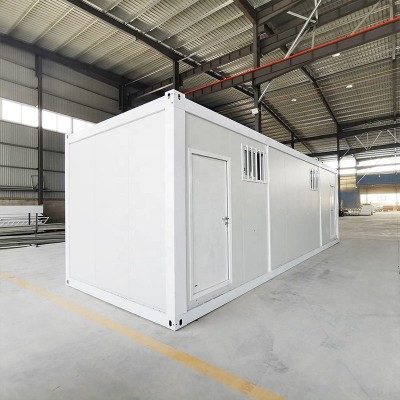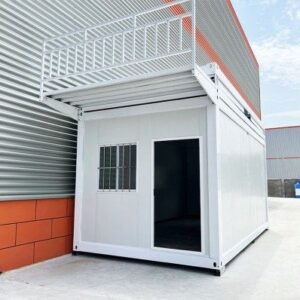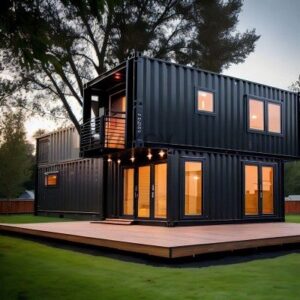Step-by-Step Process to How To Build A Shipping Container House
Building a shipping container house involves several clear steps, each crucial for a sturdy, safe, and comfortable home. Here’s a practical breakdown that covers everything from site prep to final approval — designed especially for US homeowners looking to get started with container home construction.
Site Preparation and Foundation
Start by preparing your building site, clearing debris, leveling the ground, and addressing soil stability. The foundation type is key to supporting your container home. Common foundation options include:
- Pier Foundation: Concrete piers dug into the ground supporting containers at multiple points, ideal for uneven or sloped sites.
- Slab Foundation: A flat concrete slab poured directly on the ground, providing a strong and even base.
- Crawl Space Foundation: Raised foundation with space beneath, good for plumbing and ventilation access.
Choose the foundation type based on your site soil condition, local climate, and budget.
Container Selection and Delivery
It’s important to select containers that are structurally sound and suitable for home conversion. Standard containers usually come as:
- 20-foot or 40-foot high cube containers (extra height for better headroom).
- New or used containers—used ones are cheaper but must be carefully inspected.
When your containers arrive, inspect for rust, dents, and previous damage. Containers with major structural defects will require costly repairs or may be unsafe.
Cutting and Modifying Containers
This stage involves adapting the container to your design by creating doors, windows, and other openings. Use professional metal cutting tools, ensuring each cut is precise and reinforced to maintain structural integrity.
Structural Reinforcement and Welding
Since cutting weakens container strength, reinforcing steel frames and welding are required around all openings and joints. This step is essential for safety and durability, especially if stacking containers.
Insulating the Container Home
Proper insulation is critical because steel easily transfers heat and cold. Popular insulation types include:
- Spray Foam: Provides excellent air sealing and moisture barrier.
- Blanket Insulation (Fiberglass or Mineral Wool): Cost-effective but requires vapor barriers.
- Rigid Foam Panels: Good for walls and roofs with added moisture resistance.
Selecting the right insulation will impact energy efficiency and indoor comfort.
Installing Electrical and Plumbing Systems
Plan your electrical wiring, outlets, lighting, and plumbing before interior finishing. Containers need specialized setup to fit pipes and wires into the tight steel frame — often requiring professional help.
Interior and Exterior Finishing
For comfortable living spaces, finish interiors with drywall, flooring, and paint. Exterior cladding options like wood, metal, or composite panels improve curb appeal and provide extra weather protection.
Roofing and Weatherproofing
A well-installed roof keeps water out and regulates temperature. Options include:
- Flat or sloped roofs with waterproof membranes.
- Green roofs for added insulation.
- Rain gutters and drainage systems to protect your foundation.
Final Inspection and Approval
Once construction is complete, a final inspection ensures your container home meets all local building codes and safety regulations. This step is required to get occupancy permits and finalize your new home.
Cost Breakdown and Budget Tips for Shipping Container Homes
Building a shipping container house can be affordable, but costs vary depending on size, design, and location. Understanding typical costs per container home size and knowing where to save money helps keep your budget on track.
Typical Costs by Container Home Size
Here’s a rough estimate of what building a container home in the U.S. might cost, including modifications, permits, and basic finishes:
| Home Size | Number of Containers | Approximate Cost Range |
|---|---|---|
| Small Tiny Home | 1 (20 ft) | $20,000 to $40,000 |
| Compact Studio | 2 (40 ft containers) | $40,000 to $80,000 |
| Family Home | 3-4 containers | $80,000 to $150,000 |
| Larger Multi-Room | 5+ containers | $150,000 and up |
Keep in mind: These costs may change based on your location, quality of finishes, and any additional features like solar panels or high-end appliances.
Cost-Saving Tips for Container Home Construction
- Buy used containers: Used containers are cheaper but inspect thoroughly for rust, damage, or hazardous materials.
- Opt for simple designs: Square or rectangular layouts without extensive cutting or welding reduce labor and structural costs.
- DIY where possible: Handling some of the interior finishing or painting yourself saves contractor fees.
- Use locally sourced materials: This cuts down transportation expenses and supports the local economy.
- Plan utilities carefully: Pre-planning plumbing and electrical layouts avoids costly fixes later.
- Consider modular construction: Prefabricated interior modules can speed up building and lower costs.
Watch for These Unexpected Expenses
- Site preparation: Uneven land or poor soil may require more expensive foundation work.
- Permits and inspections: Depending on your county or city, these fees vary and can add up.
- Inspections and repairs on containers: Damage found after delivery can cause delays and additional costs.
- Insulation and climate control: Proper insulation especially in colder or very hot climates adds to upfront expenses but saves money long-term.
- Transport costs: Moving containers from port or storage to your lot can be expensive, especially in rural areas.
Being smart with your budget upfront means fewer surprises during the shipping container home construction process. Plan wisely and balance cost with quality for the best results
Shipping Container Houses What They Are Types and Sizes Pros and Cons
Shipping container houses are an innovative form of housing built using repurposed steel shipping containers. These containers are primarily designed for freight transport but have been adapted into unique, affordable, and sustainable living spaces. This method of building offers an alternative to traditional construction, appealing to those seeking eco-friendly homes or cost-effective housing solutions.
What is a Shipping Container House
A shipping container house uses one or more steel containers as the basic structure. These containers are modified with insulation, windows, doors, plumbing, and electrical systems to create fully functional residences. They can range from simple tiny homes to multi-container complexes tailored to various needs.
Types and Sizes of Shipping Containers Used for Homes
Shipping containers come in several standard sizes suitable for residential use. The most common are:
- 20-foot containers
- Dimensions: ~20 ft long x 8 ft wide x 8.5 ft high
- Ideal for tiny homes or single-room spaces
- 40-foot containers
- Dimensions: ~40 ft long x 8 ft wide x 8.5 ft high
- Offers more living space and options for layouts
- High cube containers
- Height: 9.5 ft (one foot taller than standard)
- Provides better vertical room for comfort and design flexibility
Selecting the right container size depends on your space requirements, budget, and design vision. Combining multiple containers can create larger homes or multi-story buildings.
Pros and Cons of Container Homes
Pros
- Affordability: Containers are generally cheaper than traditional build materials, reducing overall cost.
- Durability: Made from steel, containers offer sturdy, weather-resistant construction.
- Sustainability: Repurposing containers reduces waste and supports eco-friendly building practices.
- Speed of Construction: Pre-fabricated containers accelerate build time when modified and assembled.
- Mobility: Some container homes can be relocated if designed for transport.
Cons
- Insulation Challenges: Steel is a poor insulator; without proper treatment, homes can get very hot or cold.
- Space Limitations: Narrow container width (8 feet) can limit design unless multiple units are combined.
- Permitting and Zoning: Not every area easily permits container homes; local regulations vary widely.
- Structural Modifications: Cutting into containers for windows and doors requires reinforcement to maintain strength and safety.
By carefully weighing the advantages and limitations, you can decide if a shipping container home fits your lifestyle and project goals. For those interested in exploring container options, see modern container house designs for ideas and specifications.
Planning Your Shipping Container House
Define Your Budget and Requirements
Before diving into shipping container home construction, setting a clear budget is essential. Your budget directly affects container size, insulation type, finishes, and whether you go DIY or hire professionals. List your must-haves like the number of bedrooms, bathrooms, and special features to match your budget with your needs.
Key points for budgeting:
- Costs vary based on container size and condition.
- Factor in site prep, foundation, permits, and utilities.
- Include a contingency fund (10-20%) for unexpected expenses.
Find the Right Location and Understand Zoning
Choosing the perfect spot for your container house involves more than just scenery. Check local zoning laws and building codes because some neighborhoods may restrict container homes or require special permits. Contact your city or county planning office to:
- Verify if container homes are allowed.
- Understand setback and height rules.
- Confirm access to utilities like water and electricity.
Being informed upfront prevents costly delays or redesigns.
DIY Versus Hiring Professionals
Deciding between a DIY build and hiring pros depends on your skills, time, and budget.
DIY pros:
- Lower labor costs.
- Full control over the process.
DIY cons:
- Steeper learning curve.
- Time-intensive and potentially risky without experience.
Hiring professionals pros:
- Experts handle permits, construction, and safety.
- Faster, more reliable build quality.
Hiring professionals cons:
- Higher upfront costs.
Many first-time builders opt for a hybrid approach—doing some work themselves and hiring experts for complex steps like welding or systems installation.
Permits and Building Regulations
Navigating permits and regulations is critical for legal and safe container home construction. Typical permits you’ll need include:
- Building permit
- Electrical permit
- Plumbing permit
Work with your local building department to understand specific requirements, including inspections during various stages. Non-compliance can lead to fines or having to redo work, so don’t skip this step.
For more on container options that fit different budgets and needs, check out small container house choices or learn about pricing at how much is a container house.
Designing Your Shipping Container House
Basic Design Principles for Container Living
When planning your shipping container home design, remember that containers are long, narrow boxes, usually 8 feet wide and either 20 or 40 feet long. This shape means your design needs to maximize space efficiently. Open floor plans work best to avoid cramped rooms, and combining multiple containers can create wider, more functional spaces. Keep in mind: the steel shell is strong but also limits major structural changes without reinforcement.
Layout Options and Architectural Ideas
You have several layout choices depending on your needs:
- Single container homes for tiny houses or studios
- Side-by-side containers to create wider living areas
- Stacked containers for multi-story homes
- L-shaped or U-shaped formations for creating private outdoor spaces or courtyards
Architectural ideas often focus on connecting indoor and outdoor areas with wide doors or foldable walls. Large windows and skylights bring in natural light but require cutting and reinforcing the container’s steel.
Insulation and Ventilation Considerations
Proper insulation is critical since metal containers conduct heat and cold easily. You can choose from:
- Spray foam insulation that seals gaps and adds rigidity
- Blanket insulation like fiberglass or mineral wool for easier installation
- Rigid foam board insulation on walls and ceilings
Ventilation is just as important to avoid moisture buildup and keep air flowing. Consider installing energy-efficient HVAC systems or ceiling fans, and design window placements to promote cross-ventilation.
Integration of Plumbing Electrical and HVAC Systems
Container homes require smart planning for utilities:
- Electrical wiring needs to be routed through walls or false ceilings, with careful attention to moisture protection
- Plumbing systems are often installed along container intersections or through cut sections, typically requiring a crawl space or raised foundation for ease of access
- HVAC units should be compact and energy-efficient, often split systems or mini-splits to fit the limited space
Coordinate with professionals to ensure your container home meets local codes while maintaining sleek functionality. Proper early planning makes installations smoother and avoids costly fixes later.
Challenges of Building a Shipping Container House and How to Overcome Them
Building a shipping container home comes with unique challenges that can slow down your project or drain your budget if you’re not prepared. Understanding these common issues and practical solutions will help you stay on track.
Common Issues in Shipping Container Home Construction
- Corrosion and RustShipping containers are made of steel, so rust is a frequent problem, especially if the container was previously used for cargo. Without proper treatment, rust can weaken structural integrity.
- Insulation and Temperature ControlContainers are metal boxes that get hot in the summer and cold in the winter. Poor insulation leads to uncomfortable living spaces and higher energy bills.
- Permits and Zoning RestrictionsNot all locations allow container homes, and building codes can be tricky to navigate. Zoning laws might restrict where and how you can build.
- Structural ModificationsCutting out doors, windows, or combining multiple containers weakens the structure if not properly reinforced. Mistakes here can cause safety issues.
- Moisture and VentilationSteel containers can trap moisture, leading to mold and mildew if ventilation isn’t carefully planned.
- Transport and Site AccessDelivering and positioning large containers can be a logistical headache, especially in tight or hard-to-reach locations.
Solutions and Best Practices to Overcome Challenges
- Rust Prevention and Repairs
- Inspect containers carefully before purchase; avoid containers with heavy corrosion.
- Use rust-resistant paint and anti-corrosive primers during construction.
- Schedule regular maintenance to catch and fix rust spots early.
- Effective Insulation and Climate Control
- Choose insulation materials like spray foam or rigid foam boards designed specifically for metal structures.
- Incorporate proper ventilation systems such as exhaust fans and air vents.
- Consider adding thermal breaks and exterior cladding to reduce heat transfer.
- Navigating Permits and Regulations
- Work with local building authorities early to understand zoning and permit requirements.
- Hire architects or builders experienced in container home construction to handle codes and paperwork.
- Use proven shipping container house plans that comply with local standards (see modern container house options).
- Structural Reinforcement
- Plan all cuts for doors and windows carefully, reinforcing with steel beams or frames as needed.
- Consult structural engineers when combining containers to ensure stability.
- Preventing Moisture and Improving Ventilation
- Install vapor barriers and waterproof coatings on interior walls.
- Design cross-ventilation through window placement and use dehumidifiers where needed.
- Planning for Transportation and Delivery
- Choose a site accessible for large trucks and cranes.
- Coordinate delivery timing with your foundation readiness to avoid storage issues.
Proactively addressing these challenges will ensure your shipping container home project stays on budget and meets your expectations for comfort and durability. For more detailed guidance on container home building processes, check out our DIY shipping container home guide and container house plans to get started on the right foot.
Case Studies Examples of Shipping Container Houses
Looking at real-life shipping container home construction projects gives us valuable insight into what works and what to avoid. These examples highlight how versatile container homes can be, along with practical lessons for anyone planning their build.
Case Study 1 Florida Coastal Home
A family in Florida built a 2-container house near the coast. They chose 40-foot high-cube containers for extra headroom and designed an open floor plan with large windows for natural light and ventilation. Their biggest win was focusing early on insulation and ventilation, using spray foam and strategically placed vents to beat the humid climate.
Lessons learned:
- Plan insulation carefully to handle local weather.
- Large openings improve livability but need proper structural reinforcement.
- Permits took longer due to coastal zoning laws, so start early.
Case Study 2 Tiny Urban Container Home in Austin
An individual built a 320 sq ft tiny home from a single 20-foot container in Austin, TX. They kept costs low by doing most of the work themselves, relying heavily on DIY shipping container home guides. For insulation, they used rigid foam panels combined with reflective barriers to stay cool in summer.
Lessons learned:
- DIY is possible but requires commitment and solid research.
- Local regulations may limit container use in urban neighborhoods—consult before buying.
- A minimal footprint helps with zoning challenges.
Case Study 3 Sustainable Off-Grid Container in Colorado
A couple created an off-grid retreat using three containers in the Colorado mountains. They incorporated solar panels, rainwater harvesting, and composting toilets, making the build a prime example of sustainable building with shipping containers. Durable insulation and double-glazed windows kept the house comfortable year-round despite extreme weather.
Lessons learned:
- Combine container strength with green technologies for energy efficiency.
- Off-grid setups need extra planning around plumbing, power, and permits.
- Insulation quality makes a huge difference in cold climates.

Key Takeaways from These Container Home Examples
- Design to your climate: Choose insulation and ventilation strategies based on the weather where you live.
- Permits and zoning matter: Always check local container home permits and regulations early in the process.
- Balance cost and customization: DIY builds save money but expect longer timelines and a learning curve.
- Think long-term maintenance: Sealants, cladding, and paint protect your container investment over time.
These real-world builds show that with the right planning and design, a shipping container house can be a flexible, affordable, and sustainable housing option tailored to your lifestyle and location.
Maintaining Your Shipping Container House
Routine Maintenance Tips for Shipping Container Home Longevity
Keeping your shipping container house in good shape means staying on top of routine maintenance. Here are some key areas to focus on:
- Inspect the exterior regularly for rust or damage. Shipping containers are made of steel, so corrosion is the main enemy. Treat any rust spots quickly to prevent them from spreading.
- Check and reseal seams and joints every few years. Seals can crack or wear out, allowing moisture to get in, which causes mold and structural issues.
- Maintain your paint and coatings. A good protective paint layer or weatherproof coating not only looks better but also wards off rust.
- Clean gutters and drainage systems to avoid water pooling near the foundation, which can cause damage over time.
- Test and service HVAC, plumbing, and electrical systems regularly to make sure everything is running safely and efficiently.
- Monitor insulation and ventilation to prevent moisture buildup inside the container, which can lead to mold or wood rot if you used wood finishes inside.
Longevity Considerations and Repairs
A well-maintained container home can last for decades, but some repairs and updates are inevitable. Here’s what to keep in mind:
- Address structural issues immediately. If you notice any bending, warping, or cracking in the steel frame—or problems with welds—consult a professional welder or builder to fix it safely.
- Replace worn or damaged insulation to preserve energy efficiency and indoor comfort.
- Keep an eye on doors and windows. These areas are often the first to show wear and can affect your home’s security and weather resistance.
- Maintain your foundation. Whether it’s a slab, piers, or crawl space, ensure it remains level and free from cracks or settling that could stress the container’s structure.
- Plan for upgrades over time, such as adding solar panels or improving energy systems, which can extend your home’s value and reduce ongoing costs.
By committing to these maintenance routines and timely repairs, your shipping container house will stay safe, comfortable, and durable for many years



